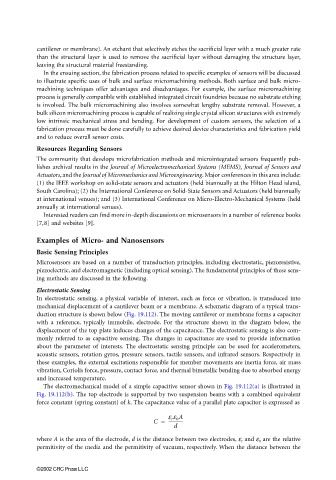Page 516 - The Mechatronics Handbook
P. 516
0066_frame_C19 Page 138 Wednesday, January 9, 2002 5:32 PM
cantilever or membrane). An etchant that selectively etches the sacrificial layer with a much greater rate
than the structural layer is used to remove the sacrificial layer without damaging the structure layer,
leaving the structural material freestanding.
In the ensuing section, the fabrication process related to specific examples of sensors will be discussed
to illustrate specific uses of bulk and surface micromachining methods. Both surface and bulk micro-
machining techniques offer advantages and disadvantages. For example, the surface micromachining
process is generally compatible with established integrated circuit foundries because no substrate etching
is involved. The bulk micromachining also involves somewhat lengthy substrate removal. However, a
bulk silicon micromachining process is capable of realizing single crystal silicon structures with extremely
low intrinsic mechanical stress and bending. For development of custom sensors, the selection of a
fabrication process must be done carefully to achieve desired device characteristics and fabrication yield
and to reduce overall sensor costs.
Resources Regarding Sensors
The community that develops microfabrication methods and microintegrated sensors frequently pub-
lishes archival results in the Journal of Microelectromechanical Systems (MEMS), Journal of Sensors and
Actuators, and the Journal of Micromechanics and Microengineering. Major conferences in this area include:
(1) the IEEE workshop on solid-state sensors and actuators (held biannually at the Hilton Head island,
South Carolina); (2) the International Conference on Solid-State Sensors and Actuators (held biannually
at international venues); and (3) International Conference on Micro-Electro-Mechanical Systems (held
annually at international venues).
Interested readers can find more in-depth discussions on microsensors in a number of reference books
[7,8] and websites [9].
Examples of Micro- and Nanosensors
Basic Sensing Principles
Microsensors are based on a number of transduction principles, including electrostatic, piezoresistive,
piezoelectric, and electromagnetic (including optical sensing). The fundamental principles of these sens-
ing methods are discussed in the following.
Electrostatic Sensing
In electrostatic sensing, a physical variable of interest, such as force or vibration, is transduced into
mechanical displacement of a cantilever beam or a membrane. A schematic diagram of a typical trans-
duction structure is shown below (Fig. 19.112). The moving cantilever or membrane forms a capacitor
with a reference, typically immobile, electrode. For the structure shown in the diagram below, the
displacement of the top plate induces changes of the capacitance. The electrostatic sensing is also com-
monly referred to as capacitive sensing. The changes in capacitance are used to provide information
about the parameter of interests. The electrostatic sensing principle can be used for accelerometers,
acoustic sensors, rotation gyros, pressure sensors, tactile sensors, and infrared sensors. Respectively in
these examples, the external excitations responsible for member movements are inertia force, air mass
vibration, Coriolis force, pressure, contact force, and thermal bimetallic bending due to absorbed energy
and increased temperature.
The electromechanical model of a simple capacitive sensor shown in Fig. 19.112(a) is illustrated in
Fig. 19.112(b). The top electrode is supported by two suspension beams with a combined equivalent
force constant (spring constant) of k. The capacitance value of a parallel plate capacitor is expressed as
e r e 0 A
C = -------------
d
where A is the area of the electrode, d is the distance between two electrodes, ε r and ε 0 are the relative
permitivity of the media and the permitivity of vacuum, respectively. When the distance between the
©2002 CRC Press LLC

